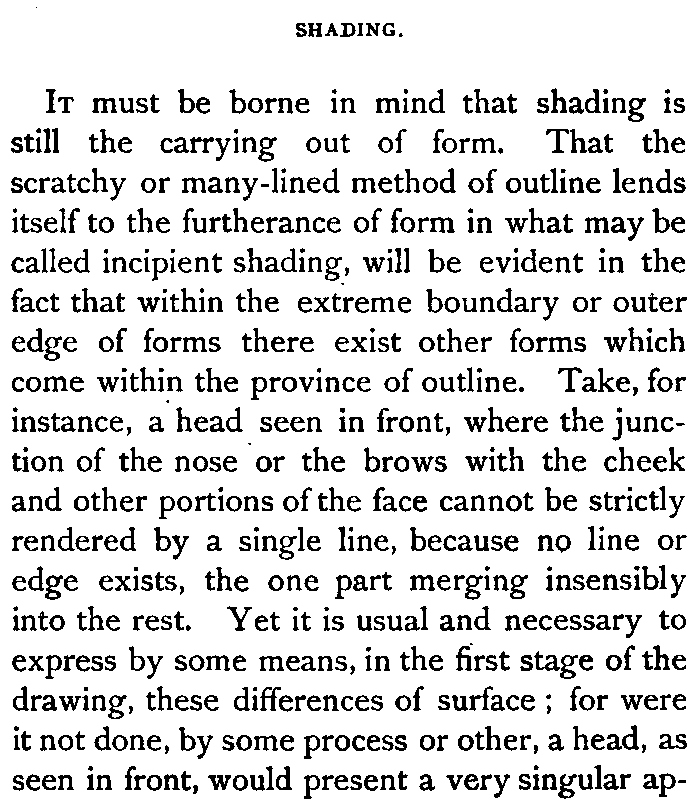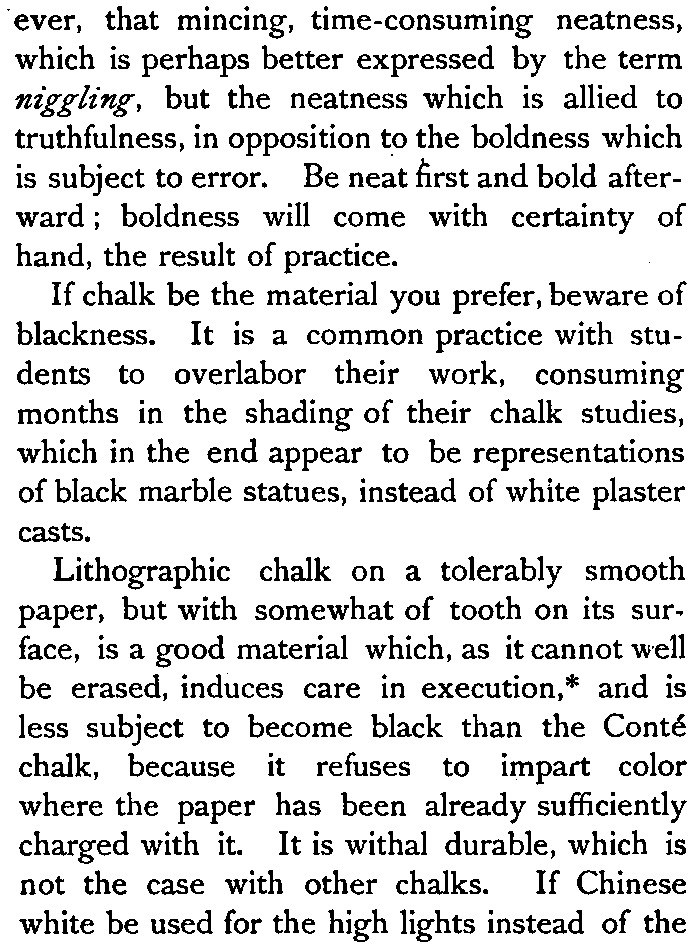
SHADING




IT must be borne in mind that shading is still the carrying out of form. That the scratchy or many-lined method of outline lends itself to the furtherance of form in what may be called incipient shading, will be evident in the fact that within the extreme boundary or outer edge of forms there exist other forms which come within the province of outline. Take, for instance, a head seen in front, where the junction of the nose or the brows with the cheek and other portions of the face cannot be strictly rendered by a single line, because no line or edge exists, the one part merging insensibly into the rest. Yet it is usual and necessary to express by some means, in the first stage of the drawing, these differences of surface ; for were it not done, by some process or other, a head, as seen in front, would present a very singular appearance as a representation of a face. If a single line be used to this end—though such is a common practice—it can be none other than a conventionalism, seeing that neither lines nor edges are to be found in what we are imitating. Some attempt at shading must therefore be adopted.
When charcoal is used—as in large heads—this can be effected by stumping or wiping into broader patches, more or less decided, those parts which appear as shades, and are thus rendered as such ; but however much of pleasurable facility there may be in the use of charcoal by the practised hand, it is quite another thing when taken up by the tyro, so let us for the present be content to use the black-lead pencil.
For the shading, as well as for the general outline, the pencil should not be too hard, neither should the paper be too rough. White paper is also to be preferred to colored in the outset ; though after some little practice, tinted paper, with white for the high lights, may be used with advantage, as much valuable time may be thereby saved.
Let neatness be a consideration. Not, however, that mincing, time-consuming neatness, which is perhaps better expressed by the term niggling, but the neatness which is allied to truthfulness, in opposition to the boldness which is subject to error. Be neat first and bold afterward ; boldness will come with certainty of hand, the result of practice.
If chalk be the material you prefer, beware of blackness. It is a common practice with students to overlabor their work, consuming months in the shading of their chalk studies, which in the end appear to be representations of black marble statues, instead of white plaster casts.
Lithographic chalk on a tolerably smooth paper, but with somewhat of tooth on its surface, is a good material which, as it cannot well be erased, induces care in execution,* and is less subject to become black than the Conte chalk, because it refuses to impart color where the paper has been already sufficiently charged with it. It is withal durable, which is not the case with other chalks. If Chinese white be used for the high lights instead of the white chalk, your drawing may be put into your portfolio as soon as finished without the chance of becoming smeared or obliterated.
The most approved method of shading the figure, either with chalk or pencil, is to lay side by side a number of lines slightly curved, to be crossed by other similar lines at an acute angle, forming lozenge-shaped apertures between their intersections. Each line should be by degrees, through greater pressure, thicker in the middle than at the end. This crossing is to be repeated, according to the required depth ; but where deep and positive tones are to be effected, the first lines to constitute the shade should be laid with a firm pressure, as the effect will be thus richer, and time will be saved.
There are many other methods of manipulation with chalk or pencil, but this, as the most general, is here given. It is the manner adopted by the French artists, as seen in the exquisite lithographs from their hands.*